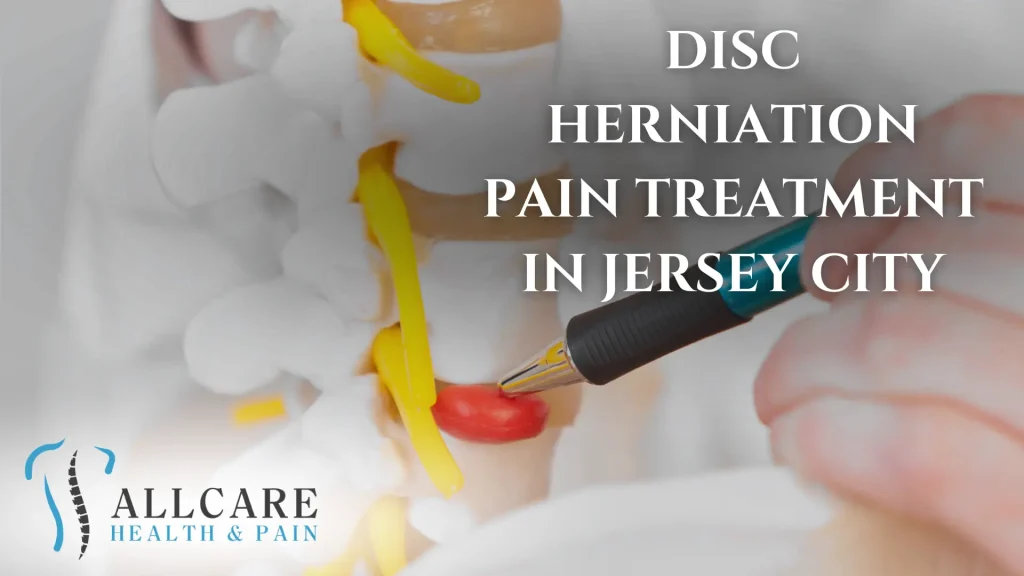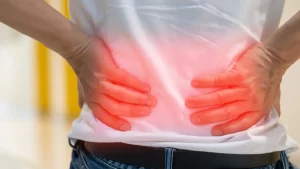
Spinal discs are donut-shaped cushions between each of your vertebrae. They act as shock absorption for your spine and allow you to twist and stretch in a wide range of motion.
Each disc is made of an outer ring of cartilage with a soft, jelly-like substance in the middle.
When the outer ring of cartilage is damaged—whether through excessive wear-and-tear, a traumatic injury, or an instance of intense lifting or twisting—the ring can crack, and the jelly-like substance can leak out. This leaking is called a herniated disc and can cause intense, radiating pain in the back and extremities.
In some instances, the leaking fluid causes the disc to bulge out and pinch nerves in the spine, causing pain. Even if the bulge doesn’t pinch a nerve, the inflammatory proteins in the leaking gel can cause pain when they come in contact with sensitive nerves.
Herniated discs can also be referred to as “ruptured discs” or “slipped discs,” although the term “slipped disc” is a little misleading. A “bulging disc” refers to a disc that has begun to change shape, but that hasn’t lost any jelly-like substance yet. Bulging discs are a precursor to herniated discs.
Causes of Herniated Discs
Spinal discs begin wearing out early in life, so some herniated discs are simply caused by natural degeneration with age. The weight of your body can cause the discs to flatten over time, putting increased pressure on the cartilage and making them more susceptible to damage. Some people are born with a genetic condition that predisposes them to disc degeneration. Your chances of herniating a disc increase if you are overweight, have poor posture, or have weak back and core muscles.
If a disc is already weakened, an excessive strain on that disc can be the final straw that causes a herniation. Excessive strain might include lifting a heavy object, twisting your back too far, or even sneezing. Being overweight or having poor posture can increase the likelihood of rupturing a disc.
Symptoms of Herniated Discs
Let’s divide the spine into three regions: the cervical region (closest to the head), the thoracic region (in the middle), and the lumbar region (closest to your tailbone).
If you have a cervical herniated disc, you might notice:
- Tingling, burning or shooting pains in one or both arms
- Weakness or numbness in one or both arms
If you have a thoracic herniated disc (which is the rarest kind), you might notice:
- Tingling, burning or shooting pains in your legs
- Trouble walking/moving legs
- Upper back or chest pain
- Trouble urinating/controlling bowels
- Headaches
If you have a lumbar herniated disc, you might notice:
- Shooting pain, burning or tingling in your legs, ankles, or feet
- Weakness or numbness in your legs, ankles or feet
- Leg pain that gets worse when you’re sitting
Treatment for Herniated Discs
 There are a wide variety of treatments for herniated discs, including both surgical and chiropractic measures. In many instances, chiropractic treatment is just as effective as surgery and a lot more convenient. However, you should consult your doctor when deciding the best treatment for you since some situations cannot be fixed with chiropractic therapy alone. For example, if your herniated disc is causing a loss of bowel control, you will require surgery.
There are a wide variety of treatments for herniated discs, including both surgical and chiropractic measures. In many instances, chiropractic treatment is just as effective as surgery and a lot more convenient. However, you should consult your doctor when deciding the best treatment for you since some situations cannot be fixed with chiropractic therapy alone. For example, if your herniated disc is causing a loss of bowel control, you will require surgery.
The following are different chiropractic treatment options:
- Manual Therapy. The chiropractor will massage muscles, stretch joints, and provide resistance in the affected areas around your herniated disc.
- Flexion-Distraction. In this therapy, the patient lays face-down on a designated table. This table stretches out the back (“distraction”) while simultaneously bending at the waist (“flexion”), causing a pumping action that helps the gel move back into the disc, improve disc height, or move discs away from nerves. Flexion-Distraction should occur for 10-minute sessions, with many repeated visits over the span of a few months.
- Manipulation Under Anesthesia (MUA). While the patient is sedated for very brief periods (usually around 6 minutes), the chiropractor will stretch and manipulate the affected area. These sessions should be repeated one to three times, each two to four weeks apart.
- Pelvic Blocking Techniques. The chiropractor will place cushioned discs under each side of the pelvis and often conduct gentle exercises. This therapy allows muscles and ligaments to relax.
Make Your Appointment with AllCare Health & Pain Today
Don’t allow back, leg, or arm pain to slow you down. Seek chiropractic help today as a non-invasive treatment option that doesn’t require surgery or excessive pain meds. At AllCare Health & Pain in Jersey City, we offer a wide range of treatment options to give you exactly the relief you need for your herniated disc, or other condition. Explore our location on Google Maps and see firsthand why we’re so highly reviewed. Call us at 201-386-9800 today.

